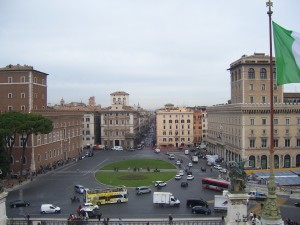My obsession with beach holidays in Italy started five years ago. Italians do indeed do many things better, and the beach is no exception. However, my first Italian beach experience intimidated the f*ck out of me. Italian beaches aren’t like the beaches I was used to at home, where I would pay an entrance fee and then the sand is seemingly my oyster to set up shop wherever and however I chose. Italian beaches implement a system of law and order, with certain etiquette/standards to which beachgoes must abide or else be subjected to a theoretical slap on the wrist. Not to toot my own horn, but I have mastered the art of getting my Italian beach on like a boss. Here are some tips so you can, too!
To bagni or not to bagni?
Beach clubs!! So, when you go to the beach in Italy, you’re likely to see rows of large, colorful umbrellas (ombrelloni) and sun beds (lettini)–two lettini to each umbrella—neatly arranged in the sand. These set-ups are not available free of charge on a first-come, first-served basis…they belong to the beach clubs (bagni) on the private beaches and you must pay for them! The umbrella colors usually delineate one beach club from another.
If you want to go the beach club route (I always do!), you must check in at the reception area first and they will assign you a spot….you don’t claim your spot then go pay for it as it might already be reserved. Prices vary, but usually two lettini and an umbrella average around 25 euro, and you can add a third lettino for an additional 7 to 10 euro. Beach clubs tend to offer weekly/monthly rates, and the rates may vary according to the beach club as well as for a position in the first row, second row, third row, etc. Obviously, the rows closer to the water cost more.
You can book for a day, yes, but many Italians reserve their beach spots for a week, a month or the whole summer. So if you show up at a beach club and there’s a “Completely Sold Out” sign yet you see empty spaces, it means someone has already reserved that spot. The reserver might not be arriving until later in the day or might just be taking that particular day off. However it doesn’t matter…that spot is theirs, and the beach club won’t offer it to someone else in their absence.
The beach clubs usually sell drinks, coffee and snacks, and have bathrooms, showers and a changing room. Many even offer cabanas for an additional cost and rent out pedal boats with water slides (which I’m dying to rent!) as well as paddle boards (dying to try!). Some, such as Stella Marina in Monterosso, also have restaurants offering sandwiches, salads and pastas, which is super convenient for lunch. (In Levanto, you’ll most likely find me at Central Beach. Alessio, the owner, rocks!)
If you do opt to take the beach club route, don’t forget to acknowledge your neighbors. Italians are super nice! Start with a “buongiorno” and then take it from there…you might just have a new friend!
Also, at a private beach, you just can’t show up and set up shop with a blanket and your own umbrella…that’s what a public beach (spiaggia pubblica) is for. However, if you paid for a spot on the private beach and want to put out a towel and lie on the sand, that’s fine, too. You just can’t put up your own umbrella if you’re a big group or rented a lettino only. It’s also worth noting that although the beaches are private, there will be still be plenty of solicitors trying to sell you coconuts and/or pineapples (which I don’t mind so much), clothing, blankets, towels, sunglasses, jewelry or Italian-language books about Africa, as well as services such as massages and hair braiding.
Usually, you can indeed rent umbrellas and sun beds on the public beaches, and there is always someone selling beach umbrellas. The public beaches fill up and get crowded fast, so it’s highly likely you’ll be sitting practically on top of the people next to you. They’re not like the vast sand expanses of Long Island or New Jersey that I grew up frequenting. I have only ever seen three tents pitched on a public beach in Italy, but they looked nice…they weren’t eyesores like those shantytown-like setups you might see on Amaghanessett Beach. (I saw one on Instagram recently that should have been illegal!)
Attire
My most favorite thing about the beaches in Italy is that all women wear bikinis! I am not perfectly toned nor will I ever be, so in the U.S., I always had a fear of wearing a bikini because society placed such a strong emphasis on “rock solid bikini bodies”. As summer approaches, pretty much every magazine cover always had something about getting a “bikini body” in an impossible to miss font size and color. Since my body never conformed to those standards, I believed that although I’ve always been slender, my body wasn’t suitable for a bikini since I wasn’t super fit, so I always opted for tankinis with boy short bottoms. In Italy, all women have bikini bodies and that’s a beautiful thing! A one-piece that covers your love handles attracts more attention to you simply because it’s a one-piece than a two-piece that reveals any loose bits. I’m just sayin’….
Men also keep the attire minimal, too, either in short, above-the-knee swim trunks or speedos. If you wear a top to cover your man boobs and/or protruding gut, you’ll attract more attention to yourself than if you had just not worn a top at all. Just let it all hang out!
Flip flops are of course appropriate, and many people wear water shoes at the rocky beaches. If you’re going to the bathroom or to grab some refreshments or even have lunch at a beach club restaurant, it’s totally fine to walk around without a cover-up, although I’m super modest so I always wear mine.
I had noticed that many Italians always have one or two additional bathing suits in tote. I wasn’t sure what this was about but my friend Christine said this was pretty much two sides of the colpo-d’-aria/aversion-to-air-conditioning coin. They change out of the wet bathing suits so there’s less of a risk of catching a draft in the wet suit. Although I’ve become a colpo d’aria believer, I just stick with one bathing suit per day.
Digestion
Digestion in Italy is a whole ‘nother story that could warrant an entire blog post in and of itself, so I’m just going to sum it up very quickly. I remember back at home, waiting a half hour after eating before jumping back into the pool would always suffice, but Italians wait at least two hours, sometimes three, to swim after eating. Blood flow is needed for digestion and if you swim, you will mess up your digestion and get really terrible cramps that could lead to death by drowning. Everyone knew someone–or knows someone who knew someone–who died because of this reason. (Note: Digestion is the reason Italians drink cappuccinos in the morning only; milk isn’t good for digestion after a proper meal.)
Basic courtesies
Of course, basic universal beach common courtesies apply. When walking in flip flops, be careful so as to not kick sand on anyone, and if you need to shake off your towel, do so in a way that doesn’t blow sand on others.




